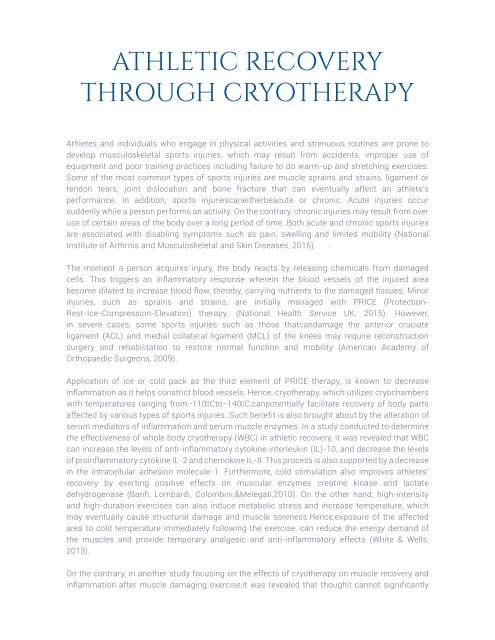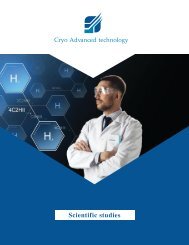BROCHURE Scientific-Studies-Cryotherapy
You also want an ePaper? Increase the reach of your titles
YUMPU automatically turns print PDFs into web optimized ePapers that Google loves.
ATHLETIC RECOVERY<br />
THROUGH CRYOTHERAPY<br />
Athletes and individuals who engage in physical activities and strenuous routines are prone to<br />
develop musculoskeletal sports injuries, which may result from accidents, improper use of<br />
equipment and poor training practices including failure to do warm-up and stretching exercises.<br />
Some of the most common types of sports injuries are muscle sprains and strains, ligament or<br />
tendon tears, joint dislocation and bone fracture that can eventually affect an athlete’s<br />
performance. In addition, sports injuriescaneitherbeacute or chronic. Acute injuries occur<br />
suddenly while a person performs an activity. On the contrary, chronic injuries may result from over<br />
use of certain areas of the body over a long period of time. Both acute and chronic sports injuries<br />
are associated with disabling symptoms such as pain, swelling and limited mobility (National<br />
Institute of Arthritis and Musculoskeletal and Skin Diseases, 2016). .<br />
The moment a person acquires injury, the body reacts by releasing chemicals from damaged<br />
cells. This triggers an inflammatory response wherein the blood vessels of the injured area<br />
become dilated to increase blood flow, thereby, carrying nutrients to the damaged tissues. Minor<br />
injuries, such as sprains and strains, are initially managed with PRICE (Protection-<br />
Rest-Ice-Compression-Elevation) therapy. (National Health Service UK, 2015). However,<br />
in severe cases, some sports injuries such as those thatcandamage the anterior cruciate<br />
ligament (ACL) and medial collateral ligament (MCL) of the knees may require reconstruction<br />
surgery and rehabilitation to restore normal function and mobility (American Academy of<br />
Orthopaedic Surgeons, 2009).<br />
Application of ice or cold pack as the third element of PRICE therapy, is known to decrease<br />
inflammation as it helps constrict blood vessels. Hence, cryotherapy, which utilizes cryochambers<br />
with temperatures ranging from−110°Cto−140°C,canpotentially facilitate recovery of body parts<br />
affected by various types of sports injuries. Such benefit is also brought about by the alteration of<br />
serum mediators of inflammation and serum muscle enzymes. In a study conducted to determine<br />
the effectiveness of whole body cryotherapy (WBC) in athletic recovery, it was revealed that WBC<br />
can increase the levels of anti-inflammatory cytokine interleukin (IL)-10, and decrease the levels<br />
of proinflammatory cytokine IL-2 and chemokine IL-8. This process is also supported by a decrease<br />
in the intracellular adhesion molecule-1. Furthermore, cold stimulation also improves athletes’<br />
recovery by exerting positive effects on muscular enzymes creatine kinase and lactate<br />
dehydrogenase (Banfi, Lombardi, Colombini,&Melegati,2010). On the other hand, high-intensity<br />
and high-duration exercises can also induce metabolic stress and increase temperature, which<br />
may eventually cause structural damage and muscle soreness.Hence,exposure of the affected<br />
area to cold temperature immediately following the exercise, can reduce the energy demand of<br />
the muscles and provide temporary analgesic and anti-inflammatory effects (White & Wells,<br />
2013).<br />
On the contrary, in another study focusing on the effects of cryotherapy on muscle recovery and<br />
inflammation after muscle damaging exercise,it was revealed that thoughit cannot significantly



